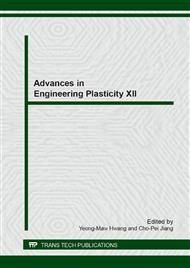p.462
p.468
p.474
p.482
p.489
p.495
p.502
p.512
p.518
Evolution of Recrystallization Textures in Plane-Strain Compressed (001)[110] Aluminum Single Crystals
Abstract:
The (001)[110] orientation of Al single crystal is known to be metastable with respect to plane strain compression to form the (112)[1 1-1] and (112)[-1-1 1] orientations, known as the copper orientations. The copper orientations did not transform into the cube texture {001}<100> after recrystallization (Rex), at variance with expectation. When Al single crystals were plane-strain compressed and recrystallized (Rexed), their Rex orientation varied with reduction in thickness. These results are discussed based on the strain-energy-release-maximization theory, in which the Rex texture is determined such that the absolute maximum stress direction (AMSD) due to dislocations in deformed materials is parallel to the minimum Young’s modulus direction in Rexed grains and other conditions, whereby strain energy release can be maximized. AMSD is obtained from slip systems activated during deformation and their activities, which were calculated from the VPSC code.
Info:
Periodical:
Pages:
489-494
Citation:
Online since:
August 2014
Authors:
Price:
Сopyright:
© 2015 Trans Tech Publications Ltd. All Rights Reserved
Share:
Citation:


